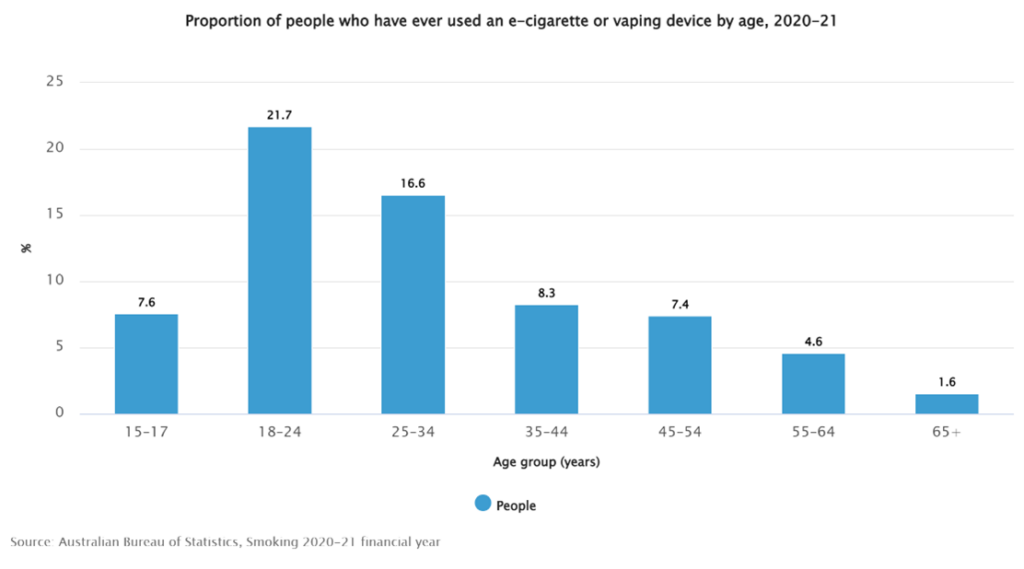The easy access to, and uptake of, vaping by young Australians is a public health crisis, writes Professor Jonine Jancey.
Due to the increasing use of vapes, particularly among young Australians, my fellow researchers and I set out to determine how these products were being promoted and sold, as both Australian and international research indicated that online purchasing is popular.

What we did
To find out what was happening in the online vaping retail environment, we identified and investigated 20 unique Australian and New Zealand retail websites. We then reviewed the product range, age verification processes, marketing strategies and claims on these sites.
What we found
Our research showed that the websites could be easily identified via a quick Google search. Most of the sites had some form of age verification, however, usually you simply clicked on a button: “yes, I am 18 years or older” and then you could enter the site to buy products.

Once you have entered the site, there was an extensive range of products to purchase.
There were disposable and pod-based vapes, and “starter kits”. Starter kits are particularly attractive to the novice vaper, as they provide all the necessary components to set you on course for a lifelong vaping habit.
There were the usual child-friendly flavoured e-liquids, some containing nicotine and some not. Four Australian websites sold nicotine e-liquids while all the New Zealand websites did.
In Australia it is illegal to sell or possess vapes or e-liquid containing nicotine, while in New Zealand nicotine vapes can be purchased; however, it is illegal to sell these products to anyone aged less than 18 years in both countries.
Many retailers also offered price discounts and/or free delivery, with some employing loyalty programs, whereby customers received points for purchases that could be redeemed for product discounts.
Retailer claims
Concerningly, unsubstantiated marketing claims, referred to health, and cessation and the social status afforded by the products, as follows.
The phrase “e-cigarettes are 95% less harmful than smoking” was frequently used by retailers.
This particular statement stems from a study criticised for its lack of hard evidence, yet it remains a common claim. Other claims were “By switching to the use of a vaporiser, you will feel your breathing improve in a matter of days” or “… if you are vaping high quality tested liquids, then you can be puffing on ZERO carcinogens”.
Yet a recent study conducted by Australian National University researchers concluded that they are far from harmless. Identified risk of vapes includes addiction, poisoning, seizures, burns and lung injury, with less direct adverse impacts including on blood pressure, heart rate and lung function. Considering these products were introduced to the United States market in 2007, their long term impact on morbidity and mortality is yet to be determined.
Status claims
Claims referred to the status and innovation obtained from vaping – “it [e-cigarette] is sleek and stylish” or “its futuristic, sleek metallic looks make it perfect for the executive on the go,” or “creative design, advanced technology, [product name] will bring you infinite pleasure”.
We believe these messages are dangerous, as potential buyers would be receptive to these appealing statements.
When it came to quitting smoking, as this is why these products were supposedly introduced, the retailers claimed, “Australian researchers find [e-cigarettes] to be more effective than nicotine replacement therapies” and “e-cigarettes are a more effective tool for helping smokers quit than nicotine replacement therapies, including patches and gum”.
These claims are questionable and the jury remains out as to whether vaping products are effective cessation tools.
What to do
Under the Therapeutic Goods Administration (TGA) Prescription Scheme, vaping products should only be accessible to adult Australians who want to quit smoking, who have a medial practitioner’s prescription.
Yet, between 2013 and 2019 vaping use tripled among young Australian adults and doubled among those aged 14–17 years – these people are not trying to quit smoking. See vaping in 2020–2021 by age group below. The graph below shows that over 20% of Australians aged 18–24 years and almost one in 12 Australians aged 15–17 years have ever used a vaping device.

To curb these growing Australian vaping rates, particularly among youth, Health Minister Mark Butler launched a public consultation through the TGA on e-cigarette products late last year.
Minister Butler described the current regulatory framework as falling short, with a need to identify actions the government can take. These actions must surely include stopping the promotion of, and easy access to vaping products through online retailers.
The Royal Australian College of General Practitioners (RACGP) made a submission to the public consultation calling for tighter regulations on vaping and a need to review existing regulation of nicotine and non-nicotine products, as vaping products labelled as being non-nicotine actually contain nicotine.
The RACGP guidelines advise medical practitioners should promote approved nicotine replacement therapy and proven pharmaceutical therapies accompanied by behavioural support before considering nicotine vaping products as a cessation tool. Nicotine vaping products should not be considered the first line option for smoking cessation.
Of course, medical practitioners should use their own judgement of their patient’s intent before prescribing any medication and vaping products should be used under the guidance of the practitioner.
Additional guidance for the use of nicotine vaping products for smoking cessation is available from the TGA website.
E-cigarettes are not a harmless product.
They contain hundreds of chemicals, stemming from e-liquids and formed by the heating element in the device, many of which are toxic.
Inaccurate statements and information once disseminated are hard to recall, and trying to dispel them just reinforces them and confuses people.
Medical practitioners play a key role in the current Australian nicotine vaping products prescription scheme.
However, beyond this, we need to restrict accessibility to, and purchase of vaping products online, along with preventing the use of unsubstantiated marketing claims.
This will require improved monitoring and better enforcement of laws regarding their sale and importation.
Professor Jonine Jancey is the Director of the Collaboration for Evidence, Research and Impact in Public Health (CERIPH) at Curtin University.
The statements or opinions expressed in this article reflect the views of the authors and do not necessarily represent the official policy of the AMA, the MJA or InSight+ unless so stated.
Subscribe to the free InSight+ weekly newsletter here. It is available to all readers, not just registered medical practitioners.
If you would like to submit an article for consideration, send a Word version to mjainsight-editor@ampco.com.au.

 more_vert
more_vert